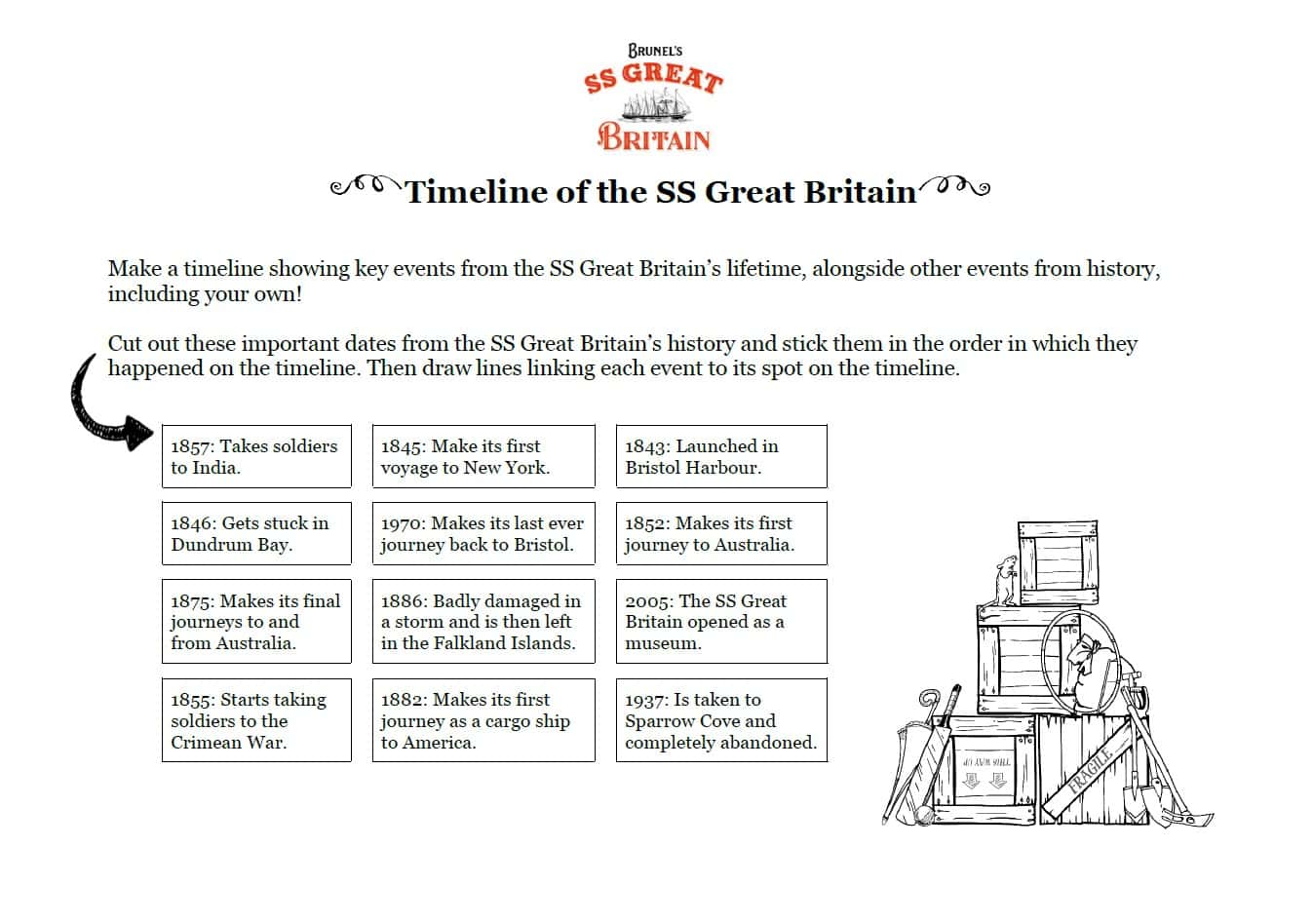SS Great Britain
1840s
The Launch and New York Voyages
Isambard Kingdom Brunel’s SS Great Britain is one of the most important historic passenger ships in the world. It was the first ship to have an iron hull, a steam engine and a screw propeller. This combination proved hugely successful and has become the inspiration for other ships even to this day.
1843: The SS Great Britain was launched in Bristol Harbour on 19 July. It had taken four years to build.
1845: The ship made the first of several transatlantic voyage to New York. It had been designed to carry just wealthy first-class passengers in every luxury. The dining saloon, for example, with real gold on the pillars had been designed to rival the fanciest hotels in London.
1846: Disaster struck! The ship ran aground in Dundrum Bay, Northen Ireland. The passengers and crew got off safely, but it remained stuck for nearly a year causing the ship’s owners to go bankrupt and eventually sell the ship to new owners.
Find out more:
SS Great Britain
Launch of the SS Great Britain
SS Great Britain Logbook
1850s
Australia Voyages and Troop Carrier
Gold had been discovered in Australia and thousands of people chose to emigrate there in the hopes of finding gold and a better life.
1852: The SS Great Britain makes its first voyage to Australia. Its new owners, Gibbs, Bright & Co, made changes to the ship to allow it to take up 700 passengers at a time to Australia. They added an extra upper deck and rather than carrying only first class, the ship now had cabins and bunks for second, third and steerage class passengers as well. With their levels of comfort and food linked to the amount of money they’d paid for their ticket!
1855-1856: The SS Great Britain was borrowed by the British Government to transport soldiers during the Crimean War. It made several trips to and from Crimea often carrying over 1500 soldiers at a time from both Britain and France.
1857-1858: Following the conclusion of the Crimean War, the SS Great Britain was used to take British soldiers and horses to India to fight in the First War of Independence.
1858: The ship returns to taking passengers to and from Australia.
Find out more:
1860s
Australia Voyages
During the 1860s people continued to emigrate to Australia on the SS Great Britain.
Many were going in the hope of finding a better life, a new job, to join family or to start new businesses. But the large numbers of people emigrating to Australia had a huge impact on the lives of Aboriginal people.
The SS Great Britain also carried passengers who were returning to the UK.
Find out more:
1870s
Australia Voyages
Throughout the early 1870s the SS Great Britain continued to carry passengers to and from Australia, but after nearly 30 years ocean travel, the ship was beginning to show its age.
1875: The SS Great Britain made its final voyage as a passenger ship back from Australia.
Find out more:
Elizabeth Parsons’ drawing book
1880s
The Cargo Ship
After 30 years as a passenger ship, the SS Great Britain was changed to carry cargo. With its steam engine and passenger cabins removed the ship carried a variety of cargo including coal and wheat between the UK and the west coast of America.
1882: The SS Great Britain made its first voyage as a cargo ship from the UK to San Fransico in America.
1886: Storms off Cape Horn badly damaged the SS Great Britain and forced Capitan Henry Stap, to seek shelter in the Falkland Islands, the closest safe port. The ship’s owners decided the cost of repairs was far too high and eventually, the SS Great Britain was sold to the Falkland Islands Company.
Find out more:
1890-1970
Falkland Islands and The Final Voyage
For over 70 years the SS Great Britain remained in the Falkland Islands slowly rusting away
1890-1933: The SS Great Britain was used as a floating warehouse.
1937: The SS Great Britain was abandoned in Sparrow Cove.
1967: Ewan Corlett, a naval architect, writes a letter to The Times newspaper stating the SS Great Britain needed to be saved and starts gathering support to save the ship.
1969: Jack Hayward donated money so that the SS Great Britain could be returned to Bristol.
1970: The SS Great Britain was rescued. After many months of research and planning Ewan Corlett had everything in place to mount a rescue operation to return the ship to the U.K. The SS Great Britain was floated on to huge floating pontoon which was then pulled by a tug boat across the Atlantic Ocean. This amazing salvage operation brought the ship 8,000 miles home to the very spot it had been built in Bristol.
Find out more:
Bath tub from the SS Great Britain





